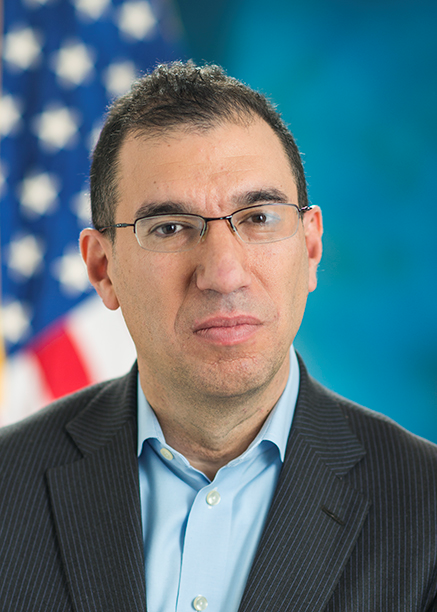open source EHRs
See the following -
A 40-Year 'Conspiracy' at the VA
 Four decades ago, in 1977, a conspiracy began bubbling up from the basements of the vast network of hospitals belonging to the Veterans Administration. Across the country, software geeks and doctors were puzzling out how they could make medical care better with these new devices called personal computers. Working sometimes at night or in their spare time, they started to cobble together a system that helped doctors organize their prescriptions, their CAT scans and patient notes, and to share their experiences electronically to help improve care for veterans...
Four decades ago, in 1977, a conspiracy began bubbling up from the basements of the vast network of hospitals belonging to the Veterans Administration. Across the country, software geeks and doctors were puzzling out how they could make medical care better with these new devices called personal computers. Working sometimes at night or in their spare time, they started to cobble together a system that helped doctors organize their prescriptions, their CAT scans and patient notes, and to share their experiences electronically to help improve care for veterans...
- Login to post comments
A Perspective of Open Source Licensing Models for the Health Care Industry
 Recently, I've had several interesting conversations about how business models based on open source technologies apply to the healthcare industry. While a lot has been written on the subject, I aim to provide a concise summary and some of my personal perspectives on the matter. This article discusses the definition of open source technology and licensing models; a second article will discuss governance models and applications in healthcare...In reality, it's hard to talk about open source licensing without talking about intellectual property (IP) and copyright. Copyright sums up the rights and obligations that the rightful owner associates with the work. The license describes the rights and obligations of any and everyone else, and can be as broad or as limited as the owner chooses.
Recently, I've had several interesting conversations about how business models based on open source technologies apply to the healthcare industry. While a lot has been written on the subject, I aim to provide a concise summary and some of my personal perspectives on the matter. This article discusses the definition of open source technology and licensing models; a second article will discuss governance models and applications in healthcare...In reality, it's hard to talk about open source licensing without talking about intellectual property (IP) and copyright. Copyright sums up the rights and obligations that the rightful owner associates with the work. The license describes the rights and obligations of any and everyone else, and can be as broad or as limited as the owner chooses.
- Login to post comments
AMA Call To Action On Health Records Should Tell Doctors To Heal Themselves
The American Medical Association (AMA) is one of the most powerful and well-known institutions in this country. Opposition from the AMA helped to bury hopes for universal healthcare back in the Harry Truman presidency, and now the AMA maintains a stranglehold on Current Procedural Terminology (CPT) codes and therefore on any innovation in reporting medical services. So when the AMA puts out a press release titled AMA Calls for Design Overhaul of Electronic Health Records to Improve Usability, describing the serious usability problems of EHRs, and announcing the release of their “solution” white paper titled Improving Care: Priorities to Improve Electronic Health Record Usability, headlines get made and policy-makers start to stir. Can a snap of the fingers by the AMA bring the EHR industry in line? Read More »
- Login to post comments
Can Open Source EHRs Offer a New Path for Health IT Usability?
 In an article published in JMIR Medical Informatics, researchers from the University of California-Davis decided to explore the small but intriguing world of open source EHRs, which may fit very neatly into the growing interest in application programming interfaces, FHIR, and other open data standards that encourage customized mix-and-match health IT development without the historical pitfalls of proprietary systems. Using data from 2014, the researchers identified 54 open source projects that met the HHS definition of an electronic health record. At the time, four of those packages had achieved Certified EHR Technology status from the ONC.
In an article published in JMIR Medical Informatics, researchers from the University of California-Davis decided to explore the small but intriguing world of open source EHRs, which may fit very neatly into the growing interest in application programming interfaces, FHIR, and other open data standards that encourage customized mix-and-match health IT development without the historical pitfalls of proprietary systems. Using data from 2014, the researchers identified 54 open source projects that met the HHS definition of an electronic health record. At the time, four of those packages had achieved Certified EHR Technology status from the ONC.
- Login to post comments
CMS Supports Open Source/Modular Medicaid Information Technology
 Investing in the future of Medicaid is one of the single biggest opportunities in the health care sector...Overall, CMS’ annual investment in state Medicaid Information Technology (IT) is more than $5 billion, enabling states to modernize their Medicaid IT systems to best meet their program, providers’ and beneficiaries’ needs. CMS and states are prepared to invest in innovative solutions. For this investment, we expect significant advances. Our new regulations require that states evolve their legacy Medicaid IT systems to leverage reusable solutions, and to practice industry-proven IT methods such as use of modularity, reuse, shared services (including Software-as-a-Service) by fundamentally shifting the financial incentives away from custom development. This opens opportunity to smaller vendors to develop focused solutions for use across multiple states or to introduce solutions from comparable sectors such as commercial insurance or large provider systems.
Investing in the future of Medicaid is one of the single biggest opportunities in the health care sector...Overall, CMS’ annual investment in state Medicaid Information Technology (IT) is more than $5 billion, enabling states to modernize their Medicaid IT systems to best meet their program, providers’ and beneficiaries’ needs. CMS and states are prepared to invest in innovative solutions. For this investment, we expect significant advances. Our new regulations require that states evolve their legacy Medicaid IT systems to leverage reusable solutions, and to practice industry-proven IT methods such as use of modularity, reuse, shared services (including Software-as-a-Service) by fundamentally shifting the financial incentives away from custom development. This opens opportunity to smaller vendors to develop focused solutions for use across multiple states or to introduce solutions from comparable sectors such as commercial insurance or large provider systems.
- Login to post comments
Communities Help Open Source EHRs Thrive (Part 1 of 3: Justification)
The next two articles in this series will examine various open source projects in the health IT space that have developed vibrant communities. But before we can appreciate the importance of those efforts, we need to understand why community is central to growth. That is the subject of this article...
- Login to post comments
Composable Software, Collaborative Development, and the CareWeb Framework
The CareWeb Framework (CWF) enables the software developer to build complex, richly interactive, web-based applications in a modular fashion...The CWF has been used as the basis for a complete EHR and CPOE system and has been ported to several open source EHRs, including OpenMRS, VistA, and RPMS. The CWF is open source software built upon open source software. Read More »
- Login to post comments
Creating EHRs that Doctors Don't Hate
 It may be difficult to recall now, what with the ongoing Cerner deployment and recent challenges that had little to do with technology, but there was a time when the Department of Veterans Affairs was considered the gold standard for healthcare IT. VA was out front with the initial development in the 1970s of the VistA system, which would come to be widely recognized and frequently honored. Indeed, when VA was overhauled in the 1990s, VistA was the primary tool that enabled the success of new policies. Without question, much of the effectiveness and durability of VA's VistA can be attributed to the way it was developed, specifically to the collaboration between technologists and clinicians that defined the process.
It may be difficult to recall now, what with the ongoing Cerner deployment and recent challenges that had little to do with technology, but there was a time when the Department of Veterans Affairs was considered the gold standard for healthcare IT. VA was out front with the initial development in the 1970s of the VistA system, which would come to be widely recognized and frequently honored. Indeed, when VA was overhauled in the 1990s, VistA was the primary tool that enabled the success of new policies. Without question, much of the effectiveness and durability of VA's VistA can be attributed to the way it was developed, specifically to the collaboration between technologists and clinicians that defined the process.
- Login to post comments
Expect an Upcoming Shake-up of Health IT Vendors in the Marketplace
Medical Economics just published their report listing the "The Top 100 EHR Companies in 2013". It makes for very interesting reading. According to the report, best estimates by the government currently show over 700 companies that now offer 'certified' electronic health record (EHR) systems to healthcare providers. These companies range from publically-traded software companies to start-up enterprises - and everything in between. However, the future viability of these vendors and their EHR systems has become an issue. 'Open source' EHR alternatives may offer a low risk alternative to many of proprietary vendors on the list. Read More »
- Login to post comments
InnerSource: a practical application of open source techniques within organizational boundaries
 Using open source methods within your own company--without offering up your resulting source code to the public--is called InnerSource. A report I wrote for O'Reilly Media titled Getting Started with InnerSource lays out some of the benefits of the open source model and how one company, PayPal, is carrying out both open source projects and InnerSource. Why would you want InnerSource? According to the report, your organization can grow and become more productive in several ways...
Using open source methods within your own company--without offering up your resulting source code to the public--is called InnerSource. A report I wrote for O'Reilly Media titled Getting Started with InnerSource lays out some of the benefits of the open source model and how one company, PayPal, is carrying out both open source projects and InnerSource. Why would you want InnerSource? According to the report, your organization can grow and become more productive in several ways...
- Login to post comments
O'Reilly Report Explores Open Solutions to Health IT
Although many programmers and public interest advocates come to the concepts of free software, standards, open data, and transparent institutions out of idealism, modern businesses and governments are being driven to these same solutions out of the practical need to meet high expectations with diminishing resources. The ways in which the health care field has been incrementally adopting these paths are the subject of a new report, written by me and released by O'Reilly Media, called The Information Technology Fix for Health: Barriers and Pathways to the Use of Information Technology for Better Health Care. Read More »
- Login to post comments
On the Need for Human-Centered Design in EHRs
 Health information technology (HIT) has become the hottest political issue in Washington. The healthcare industry in the United States is facing a crisis as medical facilities have spent hundreds of billions of dollars implementing electronic health record (EHR) systems, yet patients and the physicians and nurses that care for them are seeing few benefits. Congress has been holding hearings focused on detailing the problems and trying to write legislation that will provide a solution to the crisis. The HIT interoperability bill drafted by Rep. Michael C. Burgess (R-TX) is one example. These are welcome first steps. However, none of the bills currently before Congress, and none of the hearings, are addressing the two most important issues facing medical providers today. These are lack of EHR usability, and the inability to have a patients’ entire medical record at the point of care.
Health information technology (HIT) has become the hottest political issue in Washington. The healthcare industry in the United States is facing a crisis as medical facilities have spent hundreds of billions of dollars implementing electronic health record (EHR) systems, yet patients and the physicians and nurses that care for them are seeing few benefits. Congress has been holding hearings focused on detailing the problems and trying to write legislation that will provide a solution to the crisis. The HIT interoperability bill drafted by Rep. Michael C. Burgess (R-TX) is one example. These are welcome first steps. However, none of the bills currently before Congress, and none of the hearings, are addressing the two most important issues facing medical providers today. These are lack of EHR usability, and the inability to have a patients’ entire medical record at the point of care.
Open Health Round-Up For 2014: Notable Articles, Reports, And Events
Even the hidebound field of health care can undergo a lot of change over the course of one year. Key health IT trends that I saw throughout 2014 are summarized in another article. Here I'll list some of the most notable articles and reports related to open source, standards, and transparency in health. Read More »
Open Source EHRs: Will They Support Clinical Data Needs of the Future? (Part 1 of 2)
Open source software missed out on making a major advance into health care when it was bypassed during hospitals’ recent stampede toward electronic health records, triggered over the past few years by Meaningful Use incentives...As Meaningful Use ramps down and clinicians have to look for value in EHRs, can the open source options provide what they need?
- Login to post comments
Open Source in the Worldwide COVID-19 Response
 February marks the celebration of creation of the Open Source Initiative (OSI) in 1998. OSI created the standard definition of the term Open Source that helped guide many of LPI's initiatives today. Through the past year, open source provided many opportunities to organizations to continue to work, implement their projects, and continue reaching out to communities. Here are just a few examples of how open source provides opportunities through the face of COVID-19. The COVID-19 crisis brought out all the creativity of the open source movement. In every area of innovation--open source software, open data, open collaboration, and even open equipment--companies and research institutes have addressed medical and public health needs quickly. This article highlights some of the initiatives in each area.
February marks the celebration of creation of the Open Source Initiative (OSI) in 1998. OSI created the standard definition of the term Open Source that helped guide many of LPI's initiatives today. Through the past year, open source provided many opportunities to organizations to continue to work, implement their projects, and continue reaching out to communities. Here are just a few examples of how open source provides opportunities through the face of COVID-19. The COVID-19 crisis brought out all the creativity of the open source movement. In every area of innovation--open source software, open data, open collaboration, and even open equipment--companies and research institutes have addressed medical and public health needs quickly. This article highlights some of the initiatives in each area.
- Login to post comments